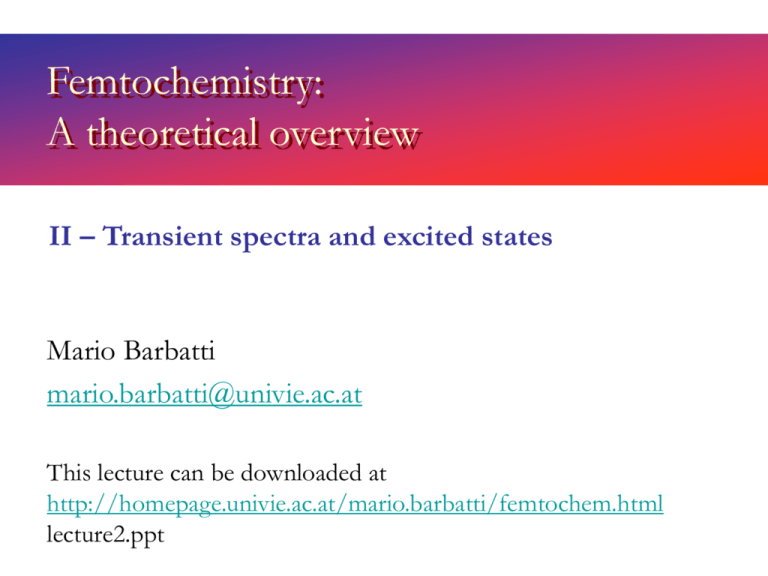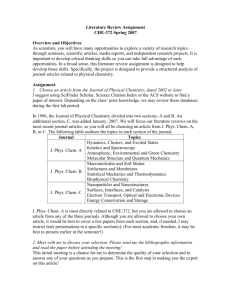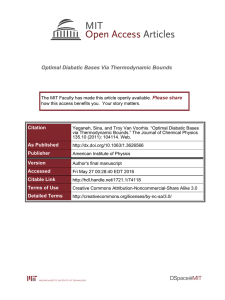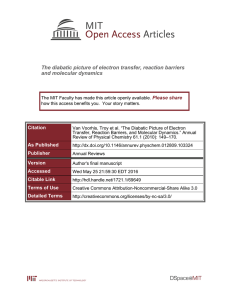PPT
advertisement

Femtochemistry: A theoretical overview II – Transient spectra and excited states Mario Barbatti mario.barbatti@univie.ac.at This lecture can be downloaded at http://homepage.univie.ac.at/mario.barbatti/femtochem.html lecture2.ppt Photoinduced chemistry and physics Energy (eV) 10 VR Singlet Triplet Ph Fl PA 0 PA – photoabsorption conical intersection avoided crossing 1 fs 10-102 fs 102-104 fs VR – vibrational relaxation 102-105 fs intersystem crossing 105-107 fs Fl – fluorescence 106-108 fs Ph – phosforescence 1012-1017 fs Nuclear coordinates Femtosecond phenomena time-resolved experiments 4 Conventional UV absorption spectrum ade absorption gua 0 cyt thy Static spectrum: information is integrated over time 5 Ultra-short laser pulses Transient spectrum: information is time resolved Fluorescence spectrum Time resolved spectra 1.0 static 0.8 transient 0.6 0.4 0.2 0.0 450 500 550 600 650 700 (nm) 7 Transient (time-dependent) spectra: pump-probe Mestdagh et al. J. Chem. Phys. 113, 240 (2000) pump t w Dt Dt + and probe td ~2000 fs td < 200 fs td < 200 fs Pump t = 60 fs = 618 nm Probe t = 6 fs probe wavelength = 560 - 710 nm Mathies et al. Science 240, 777 (1988) absorption excited state absorption (ionization) 0 transmission 0 transmission 1 1 spontaneous emission (fluorescence) stimulated emission 2 1 1 Transmission due to ground state depletion 0 Ground state absorption Stimulated emission 2 Excited state absorption 0 14 Bacteriorhodopsin 15 geometry optimization 16 Topography of the potential energy surface 17 Topography of the excited-state potential energy surface We want determine: • minima • saddle points • minimum energy paths • conical intersections 18 Newton-Raphson A bit of basic mathematics: The Newton-Raphson’s Method f(x) Prove it! f xn xn1 xn f ' xn 0 x xR x3 x2 x1 Numerical way to get the root of a function 19 Newton-Raphson To find the extreme of a function, apply Newton-Raphson’s Method to the first derivative df/dx f(x) 0 x 0 x xe x3 xe x2 x1 f ' xn xn1 xn f ' ' xn 20 Geometry optimization Taylor expansion: E x k 1 E x gx x Gradient vector: Hessian matrix: k k T k 1 1 k 1 k T x x x Hx k x k 1 x k 2 k r1 x , ri xi , yi , zi rN E / r1 g x E / rN 2 E / r12 2 E / r1r2 2 E / r1rN 2 2 2 E / r r E / r 2 1 2 H x 2 2 2 E / r r E / r N 1 N Szabo and Ostlund, Modern Quantum Chemistry, Appendix C 21 Geometry optimization At xe, g(xe) = 0 xe xk xe x k H 1 x k gx k Prove it! If H-1 is exact: Newton-Raphson Method If H-1 is approximated: quasi-Newton Method When g = 0, an extreme is reached regardless of the accuracy of H-1, provided it is reasonable. 22 Problem 1: • Get the gradient g Numerical Expensive, unreliable, however available for any method for which excited-state energies can be computed E x1 E x1 Dx E x1 Dx x1 2Dx 1 gradient = 2 x 3N energy calculations! Analytical Fast, reliable, but not generally available Two ways to get the derivative of x2 dx 2 2x dx dx 2 x Dx x Dx dx 2Dx 2 2 23 Present situation of quantum chemistry methods Methods allowing for excited-state calculations: Method MR-CISD EOM-CC SAC-CI CC2 / ADC CASPT2 MRPT2 CISD/QCISD MCSCF DFT/MRCI OM2 TD-DFT TD-DFTB FOMO/AM1 Single/Multi Reference MR SR SR SR MR MR SR MR MR MR SR SR MR Analytical gradients Coupling vectors Computational effort Typical implementation Columbus Aces2 Gaussian Turbomole Molpro Gamess Molpro / Gaussian Columbus / Molpro S. Grimme (Münster) W. Thiel (Mülheim) Turbomole M. Elstner (Braunschweig) Mopac (Pisa) 24 Problem 2: • Get the Hessian H (or H-1) Hessian has NxN = N2 elements Normally second derivatives are computed numerically Hessian matrix is too expensive! Use approximate Hessian: 1. Compute H in inexpensive method (3-21G basis, e.g.) 2. Do not compute. Use guess-and-update schemes (MS, BFGS) Example: update in the BFGS method: k k 1 k k 1 T x x x x 1 1 T H k ΛH k 1Λ T k k 1 k k 1 x x g g x k x k 1 g k g k 1 T Λk 1 T x k x k 1 g k g k 1 25 excited state relaxation 26 p p* The electronic configuration changes quickly after the photoexcitation 27 Minima in the excited states E “Spectroscopic” minimum Global minimum X • “Spectroscopic” minima are close to the FC region • Global minima often are counter-intuitive geometries 28 Minima in the excited states 7.0 6.5 V.Exc. 6.0 5.5 Energy (eV) 5.0 4.5 S2 S1 4.0 3.5 3.0 2.5 2.0 1.5 1.0 0.5 0.0 S0 0 Min S1 2 4 6 LIIC 8 10 MXS 3 29 Minima in the excited states O O HN Ground state minimum HN HC S1 “spectroscopic” minimum 30 Relaxation in the excited states O NH O HC (2) 0.6 NH 0.4 S2 1.45 1.0 0.8 1.40 0.6 0.4 S1-S2 Gap 0.2 1.35 0.2 0.0 0.0 0 50 100 150 1.60 Bond length (Å) 1.2 Energy (eV) 0.8 1.50 R(C6-N) 1.4 200 0 (d) 20 40 60 1.50 1.45 1.40 1.35 R(C2-C3) R(C4-C5) R(C2-O) 1.30 1.25 1.20 0 50 100 Time (fs) 150 200 80 100 S2 S1 S1 S2 12 1.55 Total number of hoppings Fraction of trajectories 1.0 (c) (b) (1) Bond length (Å) (a) 10 8 6 4 2 0 0 20 40 60 80 100 Time (fs) Barbatti et al., in Radiation Induced Molecular Phenomena in Nucleic Acid ( 2008) 31 Surface can have different diabatic characters Merchan and Serrano-Andres, JACS 125, 8108 (2003) 32 Minima may have different diabatic characters E Change of diabatic character np* Adiabatic surface p* p n pp* p* p n X 33 Initial relaxation may involve several states E 34 Relaxation keeping the diabatic character Merchán et al. J. Phys. Chem. B 110, 26471 (2006) 35 Relaxation changing the diabatic character 1.732 [1.772] Barbatti et al. J.Chem.Phys. 125, 164323 (2006) 36 In general, multiple paths are available 7 7 Energy (eV) 6 6 5 5 4 4 4 3 3 3 5 2 2 2 1 H3 1 2 3 4 5 1 6 S3 6 1 2 3 4 5 0 6 np* 4 4 4 3 3 3 2 2 2 B3,6 1 E3 0 1 2 3 4 5 0 6 7 7 6 6 pp* 5 1 2 3 4 5 4 3 3 2 4 5 6 p* E8 6 0 0 1 2 3 4 5 6 1/2 dMW (amu Å) np* 5 4 3 1 0 0 2 6 5 1 1 7 5 5 H3 0 0 6 pp* 4 1 7 7 p* 2 4 0 0 Energy (eV) np* 6 pp* 0 Energy (eV) 7 2 2 1 E 6 1 0 S1 0 0 1 2 3 4 1/2 dMW (amu Å) 5 6 0 1 2 3 4 1/2 dMW (amu Å) 5 6 37 Common reaction paths: efficiency R1 R1 X C O R2 Energy R2 np*/cs np* C R 4 R3 pp*/cs np* Reaction path R1 X pp* R2 R1 N C R 4 R3 H R2 n-1s p-3s* pp*/cs p* p-1s 38 The trapping effect 9H-adenine 170 fs 90 200 fs Reaction path 0 fs 120 fs 2-pyridone 0 90 180 270 360 180 (°) (°) 0 Energy (°) Energy 180 90 0 Reaction path 0 90 180 (°) 270 39 360 Radiationless decay: thymine 8 6 Energy (eV) 4 pp* 3 6 4 np* np*/cs 6,3 T1 pp* pp*/cs np* 6 pp* np* pp* 6 4 pp*/cs B np*/cs np* out-of-plane O E pp* pp*/cs np* E5 0 5 10 1/2 dMW (Å.amu ) Zechmann and Barbatti, J. Phys. Chem. A 112, 8273 (2008) 40 Radiationless decay: lifetime NH2 H N N N pyrrole Occupation 1.00 adenine S3 S4 O H N N N H pyridone S2 S1 S0 0.75 S1 S1 0.50 0.25 S2 S2 S0 S3 0.00 0 50 100 0 50 S0 100 0 50 100 150 Time (fs) pp* n-1s p-3s* p* p-1s pp*/cs np* np*/cs 41 excited-state intramolecular proton transfer ESIPT 42 Proton Transfer in 2-(2'-Hydroxyphenyl)benzothiazole (HBT) H O N proton transfer S enol absorption (nm) 325 350 O H N 8000 cm 400 -1 450 S keto emission 500 550 600 650 700 und Einstellungen\schrieve\Desktop\goldegg\hbt-cw_Graph1 43 Elsaesser and Kaiser, Chem. C:\Dokumente Phys. Lett. 128, 231 (1986) ESIPT reaction schemes H O N H Dt S1 pump O N H O N emission H O N S0 electronic configuration change keto form reaction path several modes contribute 44 DT/T0 0.005 signal at the keto wave number appears after only 30 fs Emission 0.000 DT/T solution 0.015 0.010 0.005 0.000 0 1 2 3 4 ps Lochbrunner, Wurzer, Riedle, J. Phys. Chem. A 107 10580 (2003) 6 45 46 Internal conversion should play a role 47 ESIPT gas phase 0.015 probe = 570 nm Resolution: 30 fs DT/T0 0.005 0.000 solution 0.015 0.010 0.005 0.000 0 1 2 3 4 ps 6 Schriever et al., Chem. Phys. 347, 446 (2008) Barbatti et al., PCCP 11, 1406 (2009) 48 Next lecture • Adiabatic approximation • Non-adiabatic corrections Contact mario.barbatti@univie.ac.at This lecture can be downloaded at http://homepage.univie.ac.at/mario.barbatti/femtochem.html lecture2.ppt 49









